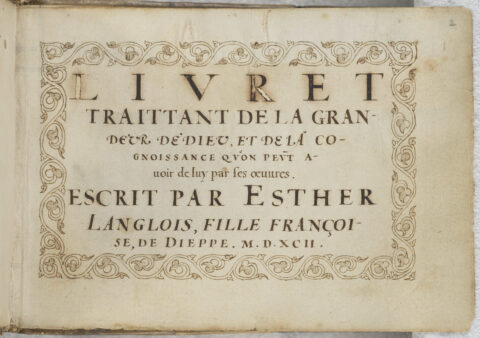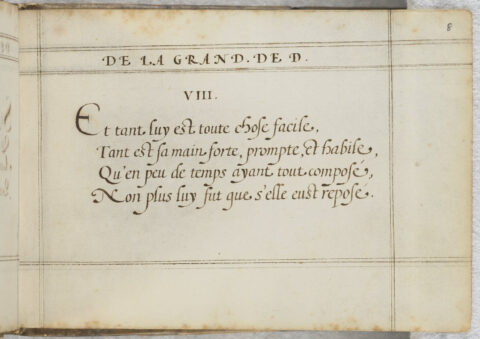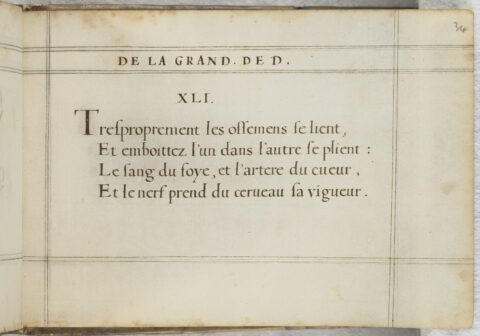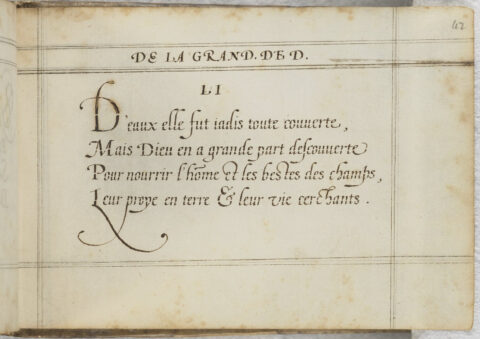At the bottom of this page, Esther Inglis writes the motto NIL PENNA SED USUS, a phrase which she uses in her manuscripts throughout her life. The motto can be translated as “the quill (pen) is nothing but of use”. It is often found in early-modern handwriting manuals, used by scribes and teachers. By copying this motto, Esther Inglis invites comparison between her work and that of professional writers, who at this time in Scotland were almost always men. Read on to find out more.
Esther Inglis’ Edinburgh

Esther Inglis’ story is closely woven into the history of the city of Edinburgh. From her parents’ first arrival as religious refugees in the 1570s to her death in Leith in August 1624, this city is a backdrop to Esther Inglis’ career as scribe, artist, illuminator, and author. Esther Inglis’ earliest known manuscripts reflect her family’s exile and her religious upbringing, and show her developing identity as a Frenchwoman in Jacobean Scotland.
In France, the family faced persecution for their Protestant faith during the French Wars of Religion (1562-1598). Having fled their home in northern France around 1570, the family moved first to London before arriving in Edinburgh between November 1571 and August 1574. London offered an initial place of safety, given the hospitality offered by Elizabeth I to protestant refugees. But by the autumn of 1574, Nicolas Langlois, Marie Presot and their young family were established in Scotland.
In Edinburgh, Nicolas Langlois supported his family by continuing his previous profession as a schoolmaster. Marie Presot was also a talented scribe, and both parents encouraged Esther Inglis to develop her calligraphy as she grew up in Scotland’s capital.
This map shows the city of Edinburgh in 1582, around eight years after the arrival of the Langlois family. Click the arrows to discover more about their life in this city.
|
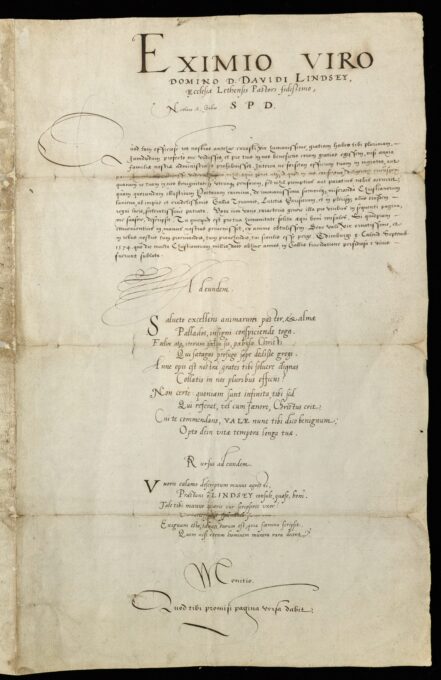
A handwritten letter of thanks
As they settled into Edinburgh, Nicolas Langlois and Marie Presot received help Edinburgh from David Lindsay, the well-connected minister of Leith. Marie Presot made this beautiful presentation copy of her husband’s letter of thanks to Lindsay; she was a skilled calligrapher, and writes here in at least four kinds of script, and several different sizes. Marie Presot signs and dates the letter on its second page, as shown below.
The poems which accompany this letter recall the massacre of the Huguenots which had taken place in Paris exactly two years before -- the Saint Bartholomew’s Day massacre. Since the Langlois family were Huguenot refugees themselves, this choice of verses is poignant; the letter emphasises the family’s good fortune in having now escaped to safety in Edinburgh.
|

|
Growing up in Edinburgh, Esther Inglis was one of at least four siblings. Her older brother David Inglis was in one of the first groups of students to attend the University of Edinburgh, which was founded in 1583 as the “Tounis College”. A university education would not have been possible for Esther Inglis; women would not be admitted to the University of Edinburgh until 1892, and she was instead educated by her own parents.
Follow the arrows to learn more about David Inglis at university.
|
Becoming Esther Langlois, Françoise
As a young woman in early-modern Scotland, Esther Inglis retained a strong sense of her French heritage. In this manuscript of devotional verse, produced in her early twenties, Inglis describes herself as “Esther Langlois, fille Françoise, de Dieppe” [Esther Inglis, a French girl from Dieppe]. Dieppe was probably the Langlois family’s hometown; it provided the main port used by Scots to leave and enter France.
Click the images below to see more pages of this manuscript, in which Esther Inglis copies the text of the printed poem De la grandeur de Dieu… [On the greatness of God] by the French bishop Pierre du Val. Inglis has copied the poem’s one hundred stanzas in 18 different styles of script, in a manuscript measuring just 9 by 12 centimetres.
See a full digitisation of this manuscript here.
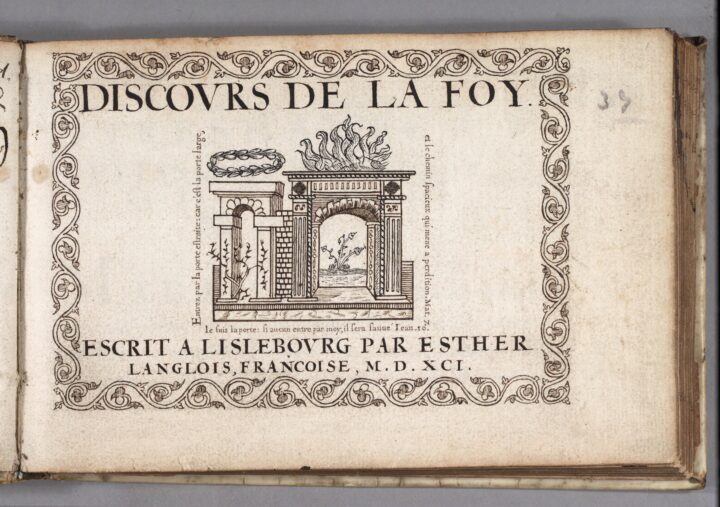
A Franco-Scottish identity
Esther Inglis describes this manuscript as “Escrit a Lislebourg par Esther Langlois, Françoise” [written in Edinburgh by Esther Langlois, a Frenchwoman]. The manuscript was a gift for Elizabeth I of England and contains an original poem in forty stanzas, calling on Protestants to defend their faith. The title-page shows that Esther Inglis identified closely with her heritage as a “françoise”, retaining the French version of her surname as she began her handwriting career in Scotland.
Read more about the religious text of this manuscript here.
|
Esther Inglis used different forms of her surname across her life and career. These changing names reflect her transnational identity as a Frenchwoman who lived in Scotland for most of her life and who also had close connections with England. This exhibition includes different forms of Esther Inglis’ surname, spoken as well as written. Listen to Anna-Nadine Pike introducing Esther Inglis’ names here.
|
Esther Inglis’ home education
Nicolas Langlois and Marie Presot both took responsibility for Esther Inglis’ education. Her father guided her reading and learning of languages, while her mother taught her handwriting. Their joint influence is reflected in a Latin couplet which Esther Inglis copied into her early manuscripts; it states that her work has been done “at the command of both parents” (mandante utroque parente).
|
||||||
| Object reference | Edinburgh University Library, MS La.III.440, folio 53r | |||||
|---|---|---|---|---|---|---|
| Credit / Usage information | University of Edinburgh, licensed under Creative Commons |

